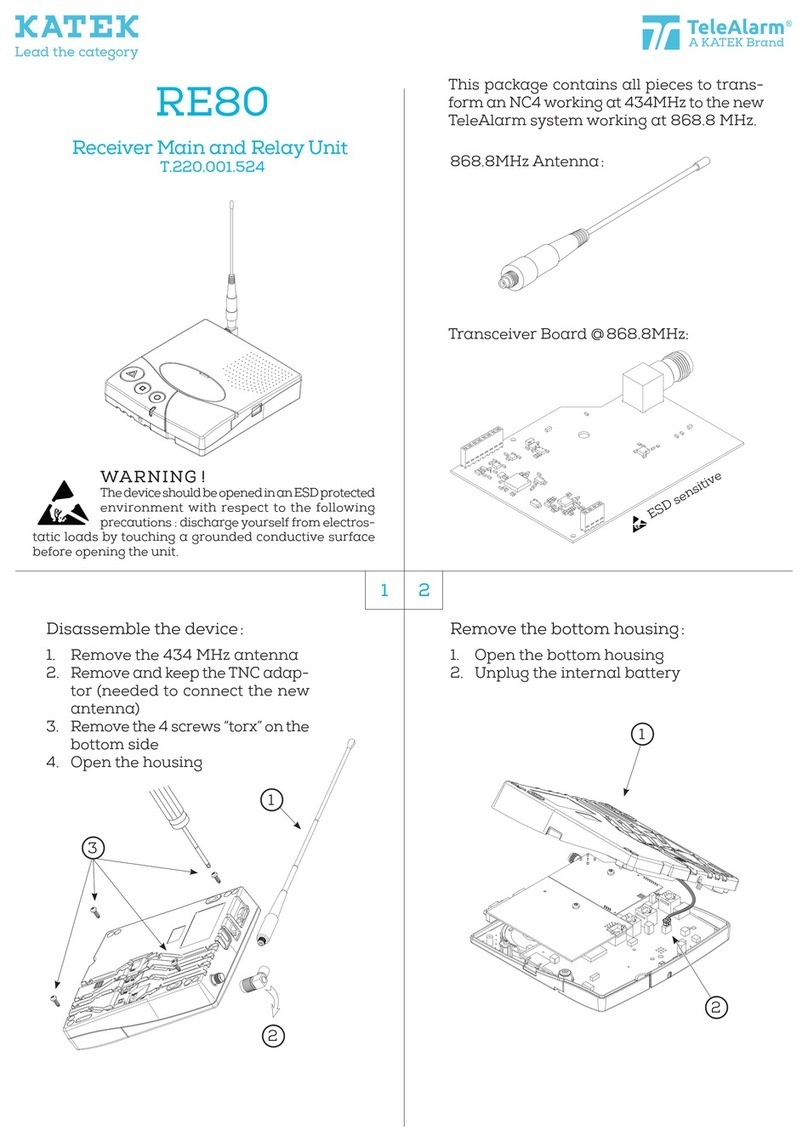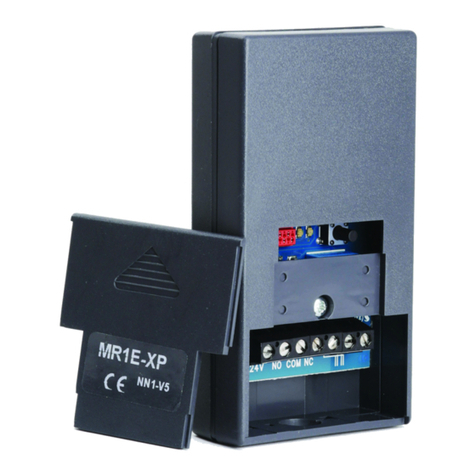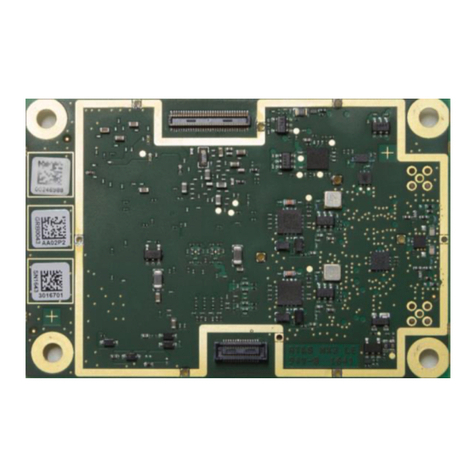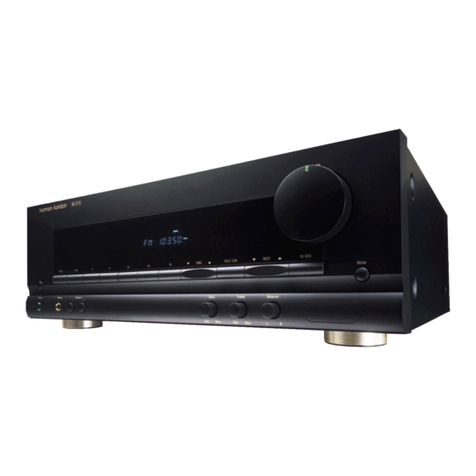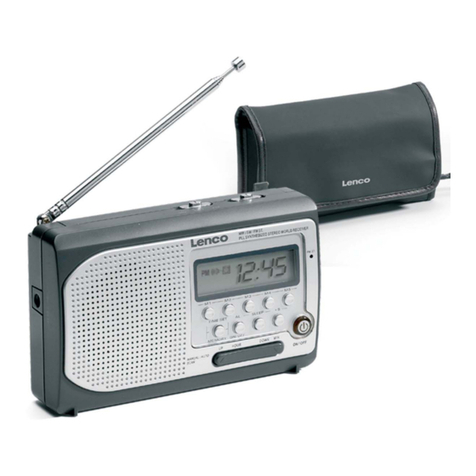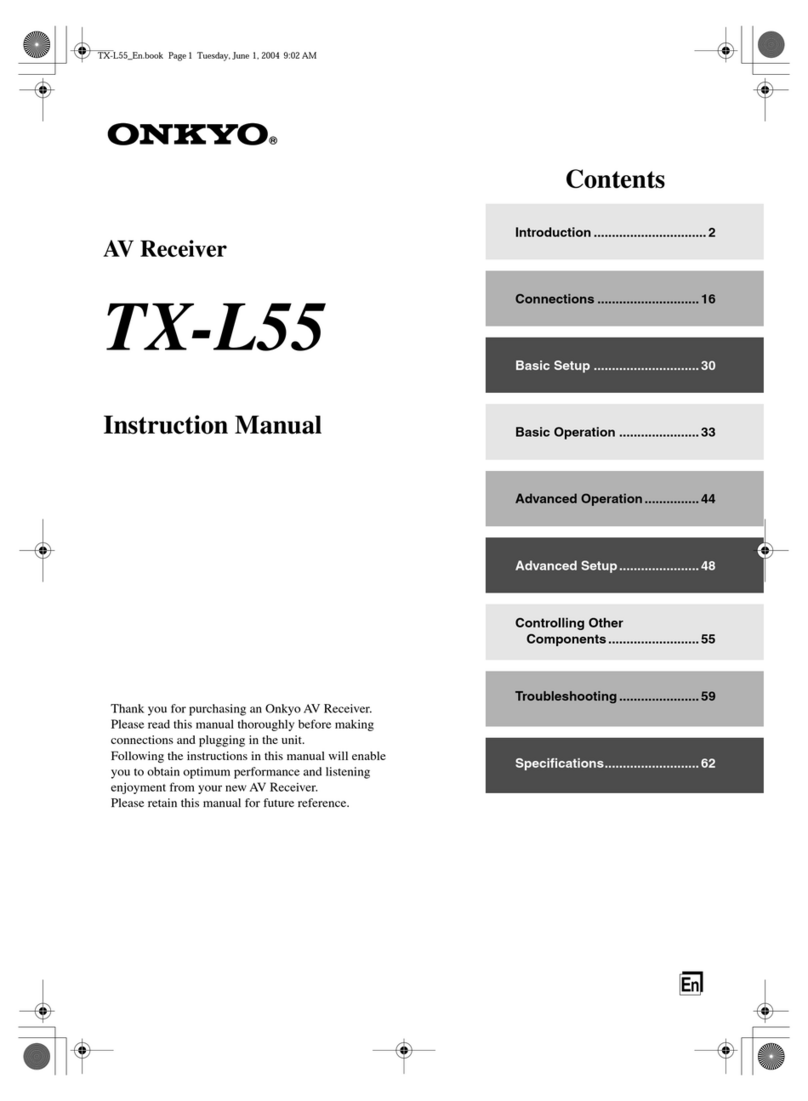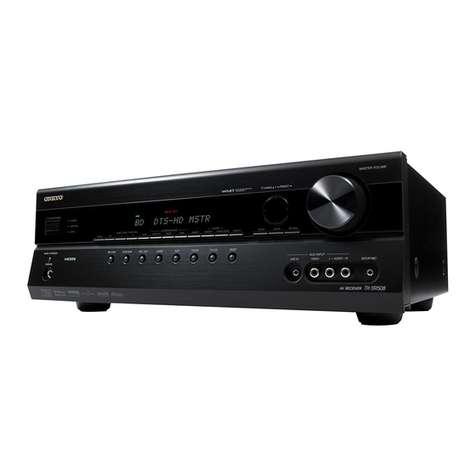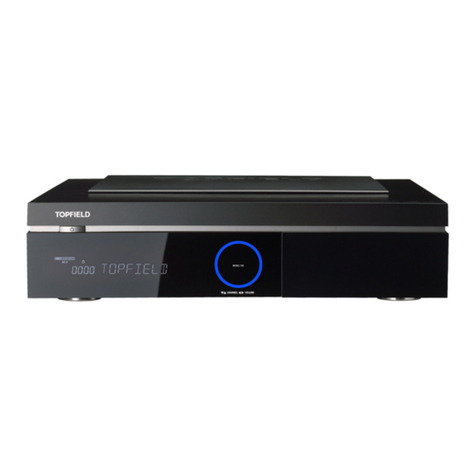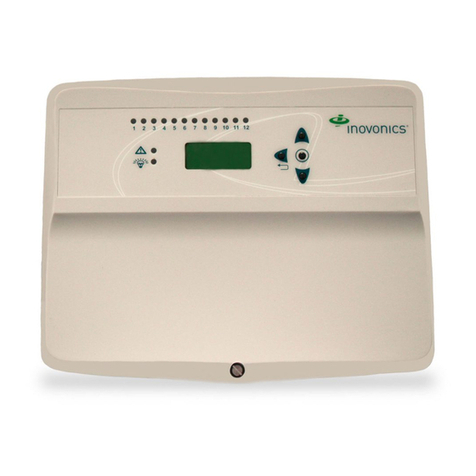KATEK TeleAlarm LE80 User manual

LE80 Radio Receiver
LE80_UM_EN_V1.1_2021.12_Final
en User Manual


LE80 Radio Receiver Table of Contents | en 3
TeleAlarm User Manual LE80_UM_EN_V1.1_2021.12
Table of Contents
1 Safety instructions 5
1.1 General safety instructions 5
1.2 Environmental conditions 5
1.3 Electrostatic Discharge (ESD) 5
2 Product information 6
2.1 General description 6
2.2 Compatible transmitters 6
2.3 Main applications 7
2.4 Description of the different modes 8
3 Installation 11
3.1 Unpacking 11
3.2 Wall installation 11
3.3 Connecting the power supply 12
3.3.1 Power supply with the RJ12 power socket 12
3.3.2 Power supply connected to a wired installation 12
4 Connection compartment 13
4.1 Connecting ports 13
4.2 Mode selection 13
5 Programming 15
5.1 Enter programming mode 15
5.4 Program a transmitter in modes 1, 2, 5, 8 or 9 16
5.5 Delete a transmitter 17
5.6 Delete all transmitters 18
5.7 Program a door address in modes 3 or 4 19
5.7.1 Programming in modes 6 or 7 19
6 Operation 20
6.1 Standby mode 20

4en | Table of Contents LE80 Radio Receiver
LE80_UM_EN_V1.1_2021.12 User Manual TeleAlarm
6.1.1 Standby with no transmitter programmed 20
6.1.2 Standby with at least one transmitter programmed 20
6.2 Normal mode (modes 1 and 2) 20
6.2.1 Activation of a transmitter in normal mode 20
6.3 Dementia (mode 3) 21
6.3.1 Activation of a S37L Wristband Transmitter 21
6.3.2 Detection of a S37E Wristband Transmitter alone 22
6.3.3 Detection of a S37L Wristband Transmitter with a S37E
Wristband Transmitter nearby 22
6.4 Dementia with Accompany (mode 4) 23
6.4.1 Activation of a S37L Wristband Transmitter 23
6.5 Remote control (mode 5) 23
6.5.1 Activation of a programmed transmitter 23
6.5.2 Activation of a programmed transmitter with a battery-low
message or with a new battery 24
6.6 Open receiver (modes 6 and 7) 24
6.6.1 Activation of a transmitter in the reception range 24
6.7 Daily messages in modes 1, 2 or 5 25
6.7.1 Daily message with battery-low signal 25
6.7.2 Reset of a battery-low indication with button T1 25
6.8 Extended N46 (mode 8 from SW 1.10 on) 25
6.9 Dual channel receiver (mode 9 from SW 1.10 on) 26
7 Maintenance 28
7.1 Cleaning 28
7.2 Storage 28
7.2.1 Short term storage conditions 28
7.2.2 Long term storage conditions 28
7.3 Disposal 28
8 Technical data 29

LE80 Radio Receiver Safety instructions | en 5
TeleAlarm User Manual LE80_UM_EN_V1.1_2021.12
1 Safety instructions
1.1 General safety instructions
Installation and initial operation should only be carried out
by trained service personnel.
1.2 Environmental conditions
The LE80 Radio Receiver must not be located near a water
tap or any other source of water. The electrical safety of the
LE80 Radio Receiver is only guaranteed if the electrical
installation is in accordance with the national regulations
and if this installation works properly. The LE80 Radio
Receiver may not be used in buildings prone to fire and
explosion hazards.
The LE80 Radio Receiver may not be used under exposure
to direct sunlight, to heat, to dust or to an excessive humidity
(only use the equipment in a clean environment).
Connect the power adapter in a power outlet near the unit.
Make sure that it remains easily accessible.
1.3 Electrostatic Discharge (ESD)
WARNING!
The LE80 Radio Receiver contains highly sensitive electronic
components. It should be opened only in an ESD protected
environment with respect to the following precautions.
Discharge yourself from electrostatic loads by touching a
grounded conductive surface before opening the unit. Avoid
touching conductive parts inside the LE80 Radio Receiver if
not absolutely necessary.

6 en | Product information LE80 Radio Receiver
LE80_UM_EN_V1.1_2021.12 User Manual TeleAlarm
2 Product information
2.1 General description
The LE80 Radio Receiver is designed to receive radio signals
from different TeleAlarm radio transmitters at the frequency
of 868.8 MHz. After receiving radio signals from either
programmed or not programmed wireless transmitters, the
LE80 Radio Receiver reacts by switching relay outputs of
two relays and by activating its two multi-colors LEDs. The
radio network works bidirectionaly, improving radio
transmission reliability.
Figure 2.1 Front view of the LE80 Radio Receiver
2.2 Compatible transmitters
All of the following TeleAlarm wireless transmitters are
compatible with the LE80 Radio Receiver:
– S87 Wristband Transmitters
– S87L Wristband Transmitters with Locating function
– B80A Wristband Transmitters with Accompany
function
– S85 Pendant Transmitters
LED 1 (green)
LED 2 (red)

LE80 Radio Receiver Product information | en 7
TeleAlarm User Manual LE80_UM_EN_V1.1_2021.12
– RAC80 Wireless Contact
– UPCBA80 Universal Transmitter
– N86 Wall Transmitters
– All TA 868.8 MHz peripherals, like smoke detector and
other accessories
2.3 Main applications
2.3.1 LE80 Radio Receiver as a small stand-alone call
system
After receiving a radio signal from a programmed radio
transmitter, the relay output switches can be used to switch
a siren or a lamp to indicate locally a wireless call.
2.3.2 LE80 Radio Receiver connected to a nurse call
system via relay contact
After receiving a radio signal from a programmed radio
transmitter, the relay will be switched. This relay output is
connected to a wired nurse call system by wire and hereby a
call will be generated or forwarded.
2.3.3 LE80 Radio Receiver as part of a NurseCall
dementia system
After receiving a signal from a S87L transmitter, the relay
will be activated to close a monitored door or passage, or to
generate a call on a wired system.

8 en | Product information LE80 Radio Receiver
LE80_UM_EN_V1.1_2021.12 User Manual TeleAlarm
2.4 Description of the different modes
Mode Name Description
1 Normal (default
mode)
20 wireless transmitters can be
programmed. Calls are indicated by LED 2
and Relay 1. A battery-low signal is
indicated by LED 2 and Relay 2.
Additionally, the custom output provides
predefined voltages for four different
predefined calls.
2 LED 2 deactivated
at battery-low
indication
The same functions as in mode 1 are
available, except for the battery-low signal
which is not indicated by LED 2, but only by
Relay 2. Additionally, the custom output
provides predefined voltages for four
different predefined calls.
3 Dementia S87L and B80A wireless transmitters are
detected. Relay 1 can be used to lock a
monitored door. Relay 2 can be used to
interrupt a monitoring device.
4 Dementia with
Accompany
This mode allows the LE80 Radio Receiver
to be connected to a wired NurseCall
system, in which the Accompany function
can be implemented. It will wait 10 seconds
after receiving a signal from a S87L
transmitter. If it detects an B80A
transmitter in this lapse of time, then no
alarm is generated. If not, then Relay 1 is
activated for 2 seconds.
5 Remote control 20 wireless transmitters can be
programmed. Per sequence, only the same
transmitter can switch on and off the Relay1.
A battery-low signal is indicated by LED 2
and Relay 2.

LE80 Radio Receiver Product information | en 9
TeleAlarm User Manual LE80_UM_EN_V1.1_2021.12
6 Open receiver No wireless transmitter needs to be
programmed. Any transmitter within
reception range of the LE80 Radio Receiver
can activate the device.
7 Open receiver with
door number
Same functions as in mode 6, but with door
position transmission. Any transmitter
within reception range of the LE80 Radio
Receiver will activate the device, but only if
the LE80 receives a datagram (at the
exception of a dementia) which contains the
door number.
8 Unique N86
transmitter
behavior
Behavior is similar to normal mode 1, with
certain differences according to the
transmitter or call type that is activated.
Triggering an alarm on a programmed N86
transmitters will activate the Relay 1 for
max. 20 min. The 20 min. cycle can be
interrupted by the acknowledgment
function of the same N86.
The Call type "Assistance" from a
programmed transmitter in repetition mode
will produce the same effect as a programed
N86. Also in this case the 20 min. cycle can
be interrupted by the acknowledgment
function of the same transmitter.
9 Dual channel
receiver
All TeleAlarm wireless transmitters can be
programmed. Calls are indicated by Relay 1
or Relay 2, according to the slot in which the
wireless transmitter is programmed. A
battery-low signal is indicated by the red
LED.
Mode Name Description

10 en | Product information LE80 Radio Receiver
LE80_UM_EN_V1.1_2021.12 User Manual TeleAlarm
NOTICE!
Factory setting is normal mode 8, in which 20 wireless
transmitters can be programmed. Calls are indicated by the
LED 2 and Relay 1. A battery-low signal is indicated by the
LED 2 and Relay 2.

LE80 Radio Receiver Installation | en 11
TeleAlarm User Manual LE80_UM_EN_V1.1_2021.12
3 Installation
3.1 Unpacking
The LE80 Radio Receiver is carefully packed for
transportation. The components contained in the box are
protected, but should be handled with care. Store the
packaging material for further use (storage or transport).
Check that the LE80 Radio Receiver have not been damaged
during transportation. In case of defective equipment, do not
try to install the LE80 Radio Receiver.
Contact immediately your local representative.
3.2 Wall installation
You can fasten the LE80 Radio Receiver on a smooth wall
surface using two screws. Installation cables should be
placed inside the cable channels on the bottom of the LE80
Radio Receiver.
A mounting plate for easy mounting preparation as well as
to give a certain mobility to the LE80 can be used. The
mounting plate works as a bracket. To fix the LE80 it must be
attached to the wall bracket and then pull it down slightly. To
remove the LE80 from the bracket the underside is raised
slightly away from the mounting plate and then pushed up
slightly. The mounting plate is only attainable in a set of 10.
Figure 3.1 Dimensions of the backside of the LE80 Radio Receiver
53.8
80
13.1
Ø7 .5
3.7
16
27
6.6

12 en | Installation LE80 Radio Receiver
LE80_UM_EN_V1.1_2021.12 User Manual TeleAlarm
3.3 Connecting the power supply
There are two different ways to connect the power supply of
the LE80 Radio Receiver. After connection, the LE80 Radio
Receiver will be in standby mode.
3.3.1 Power supply with the RJ12 power socket
The LE80 Radio Receiver can be powered by an optional
obtainable power supply unit (PSU). The PSU should be
plugged into the RJ12 socket in the installation compartment
and should be easily accessible at any time. See
Section 4.1 Connecting ports, page 13
for access to the socket.
See
Section 8 Technical data, page 29
for information about
the power supply.
3.3.2 Power supply connected to a wired installation
The LE80 Radio Receiver can be powered by an external
power supply connected to the pins cC1 and C2 of the
connection board. See
Section 4.1 Connecting ports, page 13
for information about the power supply.

LE80 Radio Receiver Connection compartment | en 13
TeleAlarm User Manual LE80_UM_EN_V1.1_2021.12
4 Connection compartment
4.1 Connecting ports
To open the device:
– hold the LE80 Radio Receiver in one hand, facing you,
so that you can see the TeleAlarm logo and the two
LEDs.
– pull the connection compartment housing (on the
bottom side) downwards.
– you can now see the connectors as in the following
illustration:
Figure 4.1 LE80 Radio Receiver connection compartment
4.2 Connectors pinout
Modes 1 to 9 can only be programmed in using the PR80
device, see
Section 5 Programming, Page 15
NOTICE!
The standby conditions of Relay 1 and Relay 2 are listed in
the table below.

14 en | Connection compartment LE80 Radio Receiver
LE80_UM_EN_V1.1_2021.12 User Manual TeleAlarm
Pin Function
C1 Input analog external power supply: 6-30 VDC, 100
mA min to source
C2 GND (external power supply)
C3 GND (custom output reference)
C4 Custom output (mode 1, 2 and 8), one second pulse,
max. 20mA
C5 Relay 1 output NO (open in standby)
C6 Relay 1 output C (common)
C7 Relay 1 output NC (closed in standby)
C8 Relay 2 output NO (open in standby)
C9 Relay 2 output C (common)
C10 Relay 2 output NC (closed in standby)
PS RJ12 connector to plug the external power supply unit

LE80 Radio Receiver Programming | en 15
TeleAlarm User Manual LE80_UM_EN_V1.1_2021.12
5 Programming
5.1 LE80 Programming method
The LE80 must be programmed in using the PR80 device
and the NurseCall Configuration Manager (NCCM) software.
The list of parameter is given in the document
"Programming Reference Manual".
The only exception is transmitters programming, which
could also be done in using the button T1 (see below).
5.2 LE80 modes
Modes 1 to 9 can be selected by the NurseCall Configuration
Manager programming tool. See detailed modes description
in
Chapter 2.4
.
5.2.1 Reduced radio range
The LE80 can be set to a reduced radio range for all modes,
using a parameter which could be programmed. In this
Mode Description
1 Normal mode (default mode)
2 LED 2 deactivated at battery-low
indication
3 Dementia
4 Dementia with Accompany
5 Remote control
6 Open receiver
7 Open receiver with door number
8 Unique N86 behavior
9 Dual channel receiver
NOTICE!
Factory setting is mode 8

16 en | Programming LE80 Radio Receiver
LE80_UM_EN_V1.1_2021.12 User Manual TeleAlarm
mode, the triggered transmitters can be received by the
LE80 only in the near distance
5.2.2 Mode indication after power on
When the power supply is connected to the LE80 Radio
Receiver, the LED 2 will blink 1 seconds in different colors,
the LED 1 will light up permanently for 2 seconds.
Afterwards, the device will display the current mode
through the LED, by blinking pink as many times as the
number of the mode. The green LED will then light up
permanently.
Example: In mode 8, the LED will blink pink 8 times.
5.3 Enter manual transmitter’s programming
mode
To enter manual transmitter’s programming mode, press
simply button T1 for one to three seconds. See button location
in
Section 4.1 Connecting ports, page 13
.
5.4 Manual programming a transmitter in
modes 1, 2, 5, 8 or 9
NOTICE!
Before programming the transmitter must be programmed
to send radio messages to the LE80, or to both NurseCall
unit and LE80.
NOTICE!
Both relays will not be activated in the programming mode.
NOTICE!
Per manual programming sequence only one transmitter
can be matched. Up to 20 transmitters can be programmed.

LE80 Radio Receiver Programming | en 17
TeleAlarm User Manual LE80_UM_EN_V1.1_2021.12
To start programming
– Press button T1 for min. 1 second and max. 3 seconds.
Device behavior
– LED 1 stays permanently green.
– LED 2 blinks red slowly for maximum 30 seconds.
Within these 30 seconds, activate the transmitter that you
want to match, the following behavior should be observed:
– LED 1 and LED 2 blink alternating green-red for 6
seconds.
This indication confirms that the transmitter is now
programmed.
– If the transmitter is already programmed, then LED 2
blinks fast red for 6 seconds after activating the
transmitter.
– If 20 transmitters are already programmed, then LED 2
blinks fast red for 10 seconds directly after activating
the button T1 between 1 and 3 seconds.
You can repeat the sequence with another transmitter.
5.5 Manual deleting a transmitter
To start deleting:
– Press button T1 for min. 5 seconds and max. 10 seconds.
NOTICE!
All programmed transmitters will be deleted only when
changing mode 1, 2, 5, 8 and 9 to mode 3, 4, 6 or 7,
NOTICE!
Per sequence only one transmitter can be deleted.

18 en | Programming LE80 Radio Receiver
LE80_UM_EN_V1.1_2021.12 User Manual TeleAlarm
Device behavior
– LED 1 stays permanently green, then after 5 seconds it
will blinks fast 5 times. After releasing T1 LED 2 will start
to blink red for 30 seconds. To delete the transmitter,
activate its button during this period.
– At that moment, LED 2 lights up permanently red for 5
seconds and then turns off.
This indication confirms that the transmitter is deleted.
When no transmitter remains programmed, LED 2 blinks
every 10 seconds three times in a row blue, till at least one
transmitter will be
programmed again.
5.6 Manual deleting all transmitters
To start deleting
– Press button T1 for minimum 20 seconds and maximum
40 seconds.
Device behavior
– LED 1 stays permanently green, then after 5 seconds, it
will blinks fast 5 times. After 20 seconds, LED 1 will start
to blink green for 20 seconds. The T1 button must be
released during this period.
– At that moment, LED 2 lights up permanently red for 5
seconds then turns off.
This indication confirms that all transmitters are then
deleted. As a second confirmation LED 2 blinks every 10
seconds three times in a row blue, till at least one
transmitter will be programmed again.
NOTICE!
If button T1 is pressed longer than 40 seconds, then the LE80
Radio Receiver will leave the programming mode.

LE80 Radio Receiver Programming | en 19
TeleAlarm User Manual LE80_UM_EN_V1.1_2021.12
5.7 Manual programming a door address in
modes 3, 4 or 7
You can program a door address stored in a transmitter
with Locating function, in modes 3, 4 or 7.
To start programming
– Press button T1 min. 1 second and max. 3 seconds.
Device behavior
– LED 1 stays permanently green.
– LED 2 blinks red slow for max. 30 seconds.
– Activate the transmitter with Locating function, which
you desire to match, before the end of the 30 seconds.
– Upon activating the transmitter, LED 1 and LED 2 blink
alternating green-red quick for 6 seconds.
This indication confirms that the door address of the
transmitter with Location function is matched in the LE80
Radio Receiver.
5.7.1 Programming in modes 6
It is neither possible nor necessary to program a transmitter
in mode 6 (open Receiver).
NOTICE!
A door address must be stored beforehand in a transmitter
with Locating function. That could also be done using the
PR80 and NCCM software.
NOTICE!
Only one door address can be matched in the LE80 Radio
Receiver.
CAUTION!
When a new door address stored in a transmitter is
programmed, it overwrites the current door address.

20 en | Operation LE80 Radio Receiver
LE80_UM_EN_V1.1_2021.12 User Manual TeleAlarm
6 Operation
6.1 Standby mode
The LE80 Radio Receiver enters standby mode when the
power supply is connected. Both relays are off. See
Section 5.2.1 Reduced radio range, Page 15
.
6.1.1 Standby with no transmitter programmed
Device behavior
– LED 1 stays permanently green.
– LED 2 blinks 3 times blue every 10 seconds.
6.1.2 Standby with at least one transmitter
programmed
Device behavior
– LED 1 stays permanently green.
– LED 2 stays permanently off.
6.2 Normal mode (modes 1 and 2)
6.2.1 Activation of a transmitter in normal mode
Device behavior
– LED 1 stays permanently green.
When a matched transmitter is activated:
– LED 2 lights up permanently red for 2 seconds.
– Relay 1 switches on for 2 seconds.
– Relay 2 stays off.
If the same or another matched transmitter is activated
within 2 seconds, the alarm will be retriggered and relay 2
will be activated for another 2 seconds (without release).
Device behavior when a transmitter has a low battery
– LED 1 stays permanently green.
When the transmitter is activated:
– LED 2 blinks red twice for 2 seconds, then blinks once
every 10 seconds.
Table of contents
Other KATEK Receiver manuals
